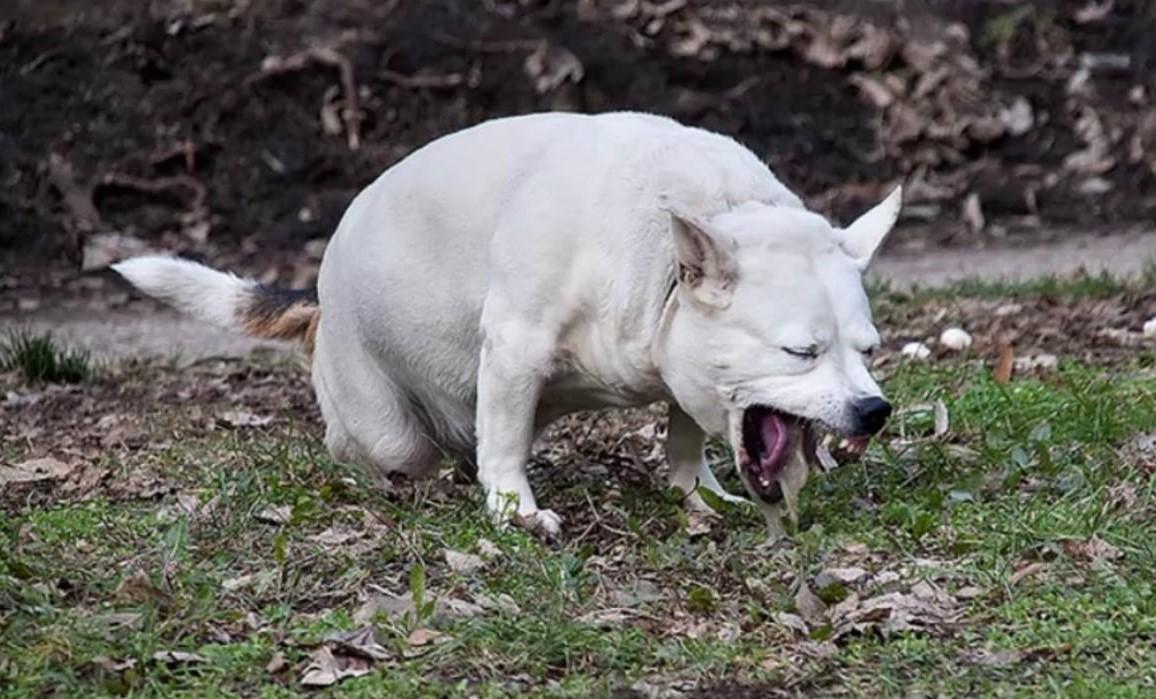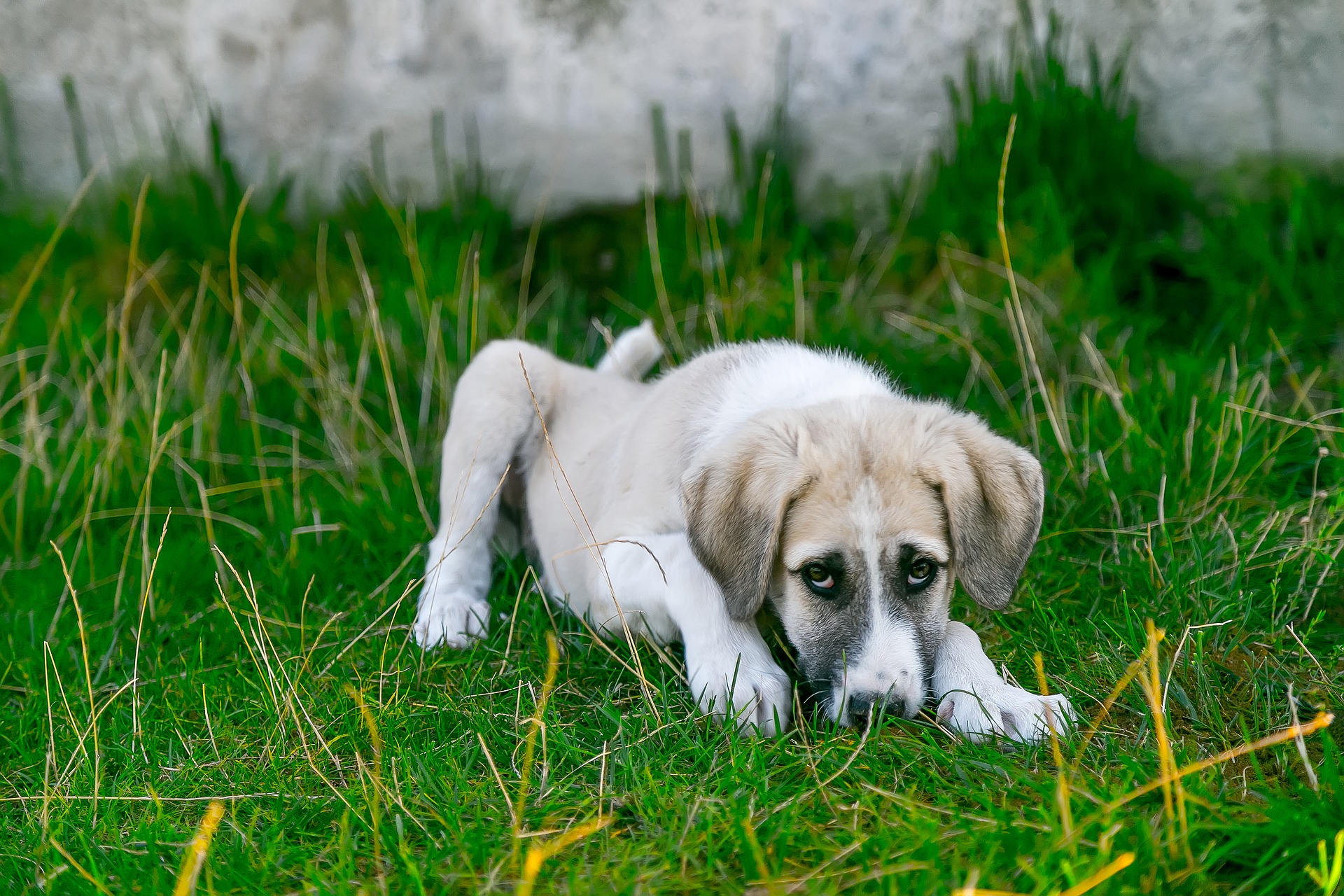My dog vomits yellow
The health of a dog that vomits yellow is not necessarily in danger, but it is necessary to determine the origin of its vomiting in order to properly treat your furry companion and not put it at unnecessary risk.
Generally, yellow vomit in dogs corresponds to a release of bile, and reflects an irritation of the animal's digestive system. Many diseases or phenomena can cause this irritation, each of which can have more or less serious repercussions on your dog's health.
What is yellow vomit in dogs?
Vomiting is a relatively common disorder in dogs, and the discharge of a yellow-colored fluid (bile) is particularly common.
Vomiting VS regurgitation in dogs
Before going further on the subject of vomiting in dogs, it is important to distinguish between two processes that owners may confuse: vomiting and regurgitation. Regurgitation occurs when the dog expels something it has just swallowed. Regurgitation differs from vomiting in that the dog does not make any effort to expel the substance in its stomach.
In the case of regurgitation, the dog may cough, but most often rejects its food as if it were spitting it out, simply by lowering its head. In addition, the food is not digested, or only very slightly. Vomiting occurs after a period of nausea and retching (contractions of the esophagus and stomach).
In most cases, the liquid that is vomited is at least partially digested and contains a yellow substance, bile, produced by the animal's digestive system during the digestion process. Therefore, unlike regurgitation, vomiting in dogs occurs in three phases: nausea, retching and vomiting.
Vomiting in dogs
Nausea, the first phase of vomiting, can be difficult to detect by the owner, as the animal does not always physically manifest its "urge to vomit". Nevertheless, nausea usually rhymes with hypersalivation, so it is possible to observe typical signs of this disorder: excessive drooling, yawning, licking of the lips, repeated swallowing, snapping of the jaws...
A nauseated dog can also adopt an equivocal behavior, such as a lack of appetite, sadness, sudden shyness... and any other sign of uneasiness. The gagging is easier to observe. During this phase, the dog contracts its stomach as if it was trying to vomit but could not. Finally, vomiting occurs when a substance - any substance - is actually expelled from the animal's stomach.
Yellow vomit in dogs
When a dog vomits a yellow substance, it is usually bile. It is also possible that your dog simply ate yellow food before vomiting, such as leftover saffron rice or chicken curry.
Bile is a yellow or even greenish biological fluid produced by the liver and stored in the gallbladder and duodenum. Bile is used to digest food (especially fats) and to neutralize stomach acid. In other words, it is normal for your dog to have a yellow substance in the stomach, and for it to be found in the digested food that is vomited.
Note that the presence of bile is most often observed by owners when the dog vomits on an empty stomach. This is called bilious vomiting, which usually occurs between meals when the dog has nothing in its stomach but the fluids its body produces. It should be noted that bile vomiting in dogs is not a disease, but a symptom of an underlying disorder.

Causes of yellow vomit in dogs
Yellow vomit in dogs is common, but it should not be overlooked. A wide variety of conditions can cause bilious vomiting, and while some are benign, others can have dramatic consequences. As a rule, yellow vomit is caused by gastritis, which is an inflammation of the stomach. Gastritis, like vomiting, is not a disease, but a symptom. In fact, to determine the cause of gastritis causing bilious vomiting, it is necessary to look for other symptoms (fatigue, digestive disorders, nervous disorders, etc.) and, at the same time, to study the vomiting itself (frequency, quantity, appearance of the bile, etc.).
Yellow Vomit and Transient Gastritis in Dogs
In the absence of any other symptoms, i.e. when the dog is behaving in a perfectly normal way, has no other digestive problems and the vomiting is isolated, the most likely cause is a temporary irritation of the stomach. There are many possible causes of this type of gastritis, the most likely being that your dog has swallowed something that has caused him gastric discomfort or pain. This can happen with a change in diet, a poorly adjusted diet, after eating grass to purge, or, if your dog is a glutton for inedible things, after ingesting a foreign object.
Food is the number one culprit in dog vomiting
These telltale symptoms include severe or mild hair and/or skin disorders (dermatitis, alopecia, redness, itching, rough and dull hair, hair loss, etc.) and overweight. Diarrhea, constipation or irregular bowel movements are also elements that may indicate that your dog is not getting enough quality food. Last but not least, the composition of his kibble or food - even if you are serving your dog a "premium" food sold by an expensive brand.It is often a second thought, but the causal link is obvious: food is the primary cause of yellow vomit in dogs. A food-related cause is mostly considered when vomiting is sporadic and the dog does not seem to have any other symptoms - in fact, it seems to be quite "normal". However, if you look hard enough, you can sometimes detect ancillary disorders that have gone undetected, either because they have not responded to any treatment until now (so they were thought to be unavoidable), or because it does not make sense to link them to eating disorders.
If the composition of your dog's food includes a good number of cereals and/or legumes, with a ratio of less than 25% protein and less than 15% fat, you can already suspect that the contents of his bowl are the cause of chronic gastritis. Note that in this case, and especially if your dog is a little too fat (often despite a "light" diet), it is likely that his diet causes him frequent gastritis that goes completely unnoticed, as bilious vomiting does not systematically occur in case of stomach irritations.
Obese dogs, gluttons who devour their toys, grass or anything else they can get their hands on, are typically dogs with gastric pain that they try to soothe by filling their stomachs - a technique that works temporarily. To keep your dog healthy and sane, take a close look at his diet: you may be surprised at how many minor (but painful and anxiety-provoking) ailments disappear with a healthy diet.
Also, owners of overweight dogs who can't lose weight no matter how hard they try, destructive pets who will nibble on anything, or dogs with unexplained dermatitis that is impossible or difficult to treat, can benefit greatly from taking a close look at their dog's food bowl.
Dog Poisoning
Ingestion of toxic products can also irritate your dog's stomach lining and cause bilious vomiting. To rule out or prove the theory of poisoning, go around your home and look for what your dog might have swallowed. Beware: there are many possibilities, and not always where you expect them. Indeed, if we think at first sight of household products, antifreeze or oleanders from the garden, we should also note that foods that seem harmless to us can be very toxic for dogs. This is the case with onions, garlic, leeks, Doliprane, chocolate, grapes... and many other human foods. The appearance of diarrhea and nervous disorders (tremors, paralysis, convulsions...) are typical - but not systematic - symptoms of poisoning.
Intestinal obstruction and yellow vomit in dogs
More serious, but fortunately rarer, causes can also be behind your dog's yellow vomit. Intestinal obstruction is still a fairly common disorder in dogs, especially in leggy vacuum cleaners, those who don't hesitate to gobble up objects that don't belong in a stomach, as well as in destroyers who like to shred their toys at the risk of swallowing a piece. This pathology is particularly painful, so the dog often presents a depression, distress and a great malaise. Generally, the animal does not eat anymore, and its abdomen is hard, swollen and painful. Intestinal obstruction is a true veterinary emergency: if you suspect your dog has it, run to the veterinary emergency room without delay!
Metabolic diseases and yellow vomit in dogs
Metabolic disorders resulting in organ dysfunction can also be the cause of bilious vomiting in dogs. Pancreatitis, an inflammation of the pancreas, can afflict dogs in a chronic or acute form. In the acute form, vomiting is repeated and often accompanied by depression, anorexia, and analgesic postures. In the chronic form, the disease is insidious and progresses slowly, first manifesting itself with sporadic vomiting before presenting more severe symptoms.
Hepatitis, an inflammation of the liver, can also cause vomiting, sometimes accompanied by jaundice, as can pyelonephritis (kidney infection), kidney failure or cancer of the digestive organs. The context of the yellow vomiting is also important: if it occurs during or after a trip, it's quite possible that your dog has motion sickness. If it occurs while your dog is on medication, it's possible that it's the medication that's irritating his stomach (especially anti-inflammatory drugs).
In the latter case, do not discontinue your dog's medication without your veterinarian's advice, but contact your veterinarian promptly to get his or her opinion on the matter. Finally, the presence of internal parasites (worms), stress and digestive or nervous diseases can also be the cause of yellow vomit in dogs.

Consequences of Yellow Vomit in Dogs
The consequences of bilious vomiting in dogs depend entirely on the pathologies involved in its occurrence. In case of metabolic diseases (hepatitis, cancer, renal failure, etc.), the prognosis is often worse. When vomiting is caused by true veterinary emergencies (intestinal obstruction, poisoning, etc.), the speed of the animal's treatment will greatly impact its chances of survival.
In the case of chronic gastritis, it is possible to see the animal develop digestive disorders over the long term, eventually fatiguing the organs involved in the digestive process. When this type of phenomenon is not managed, often because it is not diagnosed, it often results in a decreased life expectancy and the persistence of "benign" disorders (gastric pain, psychological discomfort, skin disorders) that will plague the animal for the rest of its life.
What to do when a dog vomits yellow
If your dog has vomited yellow once or twice, has no other symptoms and is in good health, simple monitoring may be all that is needed. It's probably a temporary gastritis, due to eating grass to purge, eating too quickly or staying empty too long.
If vomiting recurs, whether or not at a distance, but still without other symptoms, make sure that his food is well adapted to his needs and of sufficient quality so as not to irritate his stomach - even if it is a diet he has tolerated well for a long time. If vomiting persists despite proper feeding, whether frequent or occasional, consult a veterinarian.
On the other hand, if your dog shows other symptoms, or if it is a puppy or a fragile or sick animal, consult a veterinarian quickly. Diarrhea, especially hemorrhagic diarrhea, should alert you, as well as depression, signs of pain, a swollen abdomen, fever, anorexia or any unusual behavior.
Also watch for the appearance of your dog's vomit, even if it's not very pleasant. Spitting up, yellow vomit with traces of blood, black dots (digested blood) or parasites should prompt you to seek urgent attention.

FAQ
What should I do if my dog vomits yellow?
If your dog has only vomited once, check the absence of any other symptom: diarrhea or constipation, fever, pain, swollen abdomen, skin disorders, nervous disorders (tremors, convulsions...), mobility disorders (lameness, paralysis...), depression, sadness, aggressiveness... If your dog is completely normal, it is probably a temporary gastritis: watch him closely, and make sure that nothing evolves. When your dog vomits several times or shows other symptoms, take him to a veterinarian quickly.
Why does my dog vomit yellow?
The yellow substance found in dog vomit is bile, a liquid produced by the liver to digest food. It is normal to find bile in a dog's vomit, either alone or mixed with digested food. However, vomiting should not be overlooked, and it is essential to determine the cause to rule out serious illness.
My dog is vomiting yellow, is it because he is purging?
Dogs can purge to get rid of something that irritates their stomach. In this case, they are often seen eating grass before vomiting. However, a dog does not always vomit yellow because he is purging, there can be several causes for bilious vomiting. On the other hand, a dog that tries to purge regularly probably has an underlying disorder (chronic gastritis), so it is essential to consult a veterinarian.
My dog is vomiting yellow, is it serious?
Fortunately, in most cases a dog that vomits bile is not in immediate danger. If your dog has no symptoms and is behaving in a normal manner, he or she is probably just experiencing a mild gastric irritation. However, even when bilious vomiting is not life-threatening, it is still caused by something that is causing your dog to suffer: most often, that something is in his bowl, so it is crucial to make sure your dog is fed properly.
Finally, in some cases, yellow vomit in dogs is caused by a more serious illness. To avoid putting your dog at unnecessary risk, take him to the vet if you have any doubts. A dog that vomits yellow is most often suffering from gastric irritation due to something he or she has swallowed, stress or waiting too long between meals.
If your dog is purging regularly or vomiting occasionally, it's important to address the most common culprit: his diet. Industrial kibbles, in particular, have a knack for being poorly formulated and full of irritating ingredients that can cause bilious vomiting and many other problems that your dog may have experienced, but for which you may not have found the cause.

